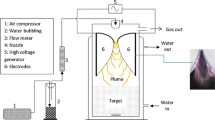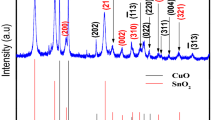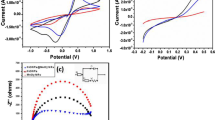Abstract
A rutile TiO2 (α-TiO2) and hexagonal wurtzite ZnO nanocomposite was directly and synchronously synthesized via arc discharge method submerged in de-ionized water. In correlation with the detailed characterization of the morphology, and crystalline structure of the prepared ZnO–TiO2 nanocomposites, the UV–visible and photoluminescence properties were studied. X-ray diffraction and transmission electron microscopy investigations revealed the co-existence of α-TiO2 and hexagonal wurtzite ZnO phases with the ZnO and α-TiO2 nanoparticles are in nanorod and nanospheres morphologies, respectively. The diameters of the synthesized nanocomposite particles are in the range of 5–70 nm. Interestingly, the as-prepared ZnO–TiO2 nanocomposite shows better photocatalytic activity for photodegradation of the methylene blue dye than both of pure ZnO and TiO2 nanocatalyts. This work would explore feasible routes to synthesize efficient metal or/and metal oxide nanocomposites for degrading organic pollutants, gas sensing or other related applications.






Similar content being viewed by others
References
N.K. Perkgoz et al., Photocatalytic hybrid nanocomposites of metal oxide nanoparticles enhanced towards the visible spectral range. Appl. Catal. B 105(1–2), 77–85 (2011)
H.S. Bae et al., Photo detecting properties of ZnO-based thin-film transistors. Appl. Phys. Lett. 83(25), 5313–5315 (2003)
U. Özgür et al., A comprehensive review of ZnO materials and devices. J. Appl. Phys. 98(4), 041301 (2005)
A.M. Azad et al., High-temperature immittance response in anatase-based sensor materials. J. Am. Ceram. Soc. 77(12), 3145–3152 (1994)
T. Ohno et al., Synergism between rutile and anatase TiO2 particles in photocatalytic oxidation of naphthalene. Appl. Catal A-General 244(2), 383–391 (2003)
P. Hoyer, H. Weller, Size-dependent redox potentials of quantized zinc-oxide measured with an optically transparent thin-layer electrode. Chem. Phys. Lett. 221(5–6), 379–384 (1994)
J. Demerchant, M. Cocivera, Preparation and doping of zinc-oxide using spray-pyrolysis. Chem. Mater. 7(9), 1742–1749 (1995)
T. Maruyama, J. Shionoya, Zinc-oxide thin-films prepared by chemical vapor-deposition from zinc acetate. J. Mater. Sci. Lett. 11(3), 170–172 (1992)
M. Izaki, T. Omi, Transparent zinc oxide films prepared by electrochemical reaction. Appl. Phys. Lett. 68(17), 2439–2440 (1996)
J.U. Brehm, M. Winterer, H. Hahn, Synthesis and local structure of doped nanocrystalline zinc oxides. J. Appl. Phys. 100(6), 064311 (2006)
H. Wang et al., Large-scale synthesis of single-walled carbon nanohorns by submerged arc. Nanotechnology 15(5), 546–550 (2004)
N. Sano et al., Nanotechnology—synthesis of carbon ‘onions’ in water. Nature 414(6863), 506–507 (2001)
N. Sano et al., Fabrication of inorganic molybdenum disulfide fullerenes by arc in water. Chem. Phys. Lett. 368(3–4), 331–337 (2003)
A.A. Ashkarran et al., ZnO nanoparticles prepared by electrical arc discharge method in water. Mater. Chem. Phys. 118(1), 6–8 (2009)
L.F. Dong, Z.L. Cui, Z.K. Zhang, Gas sensing properties of nano-ZnO prepared by arc plasma method. Nanostruct. Mater. 8(7), 815–823 (1997)
F. Fang, et al., UV and humidity sensing properties of ZnO nanorods prepared by the arc discharge method. Nanotechnology 20(24), 245502 (2009)
V. Eskizeybek, A. Avci, M. Chhowalla, Structural and optical properties of CdO nanowires synthesized from Cd(OH)(2) precursors by calcination. Cryst. Res. Technol. 46(10), 1093–1100 (2011)
V. Eskizeybek et al., Synthesis and characterization of cadmium hydroxide nanowires by arc discharge method in de-ionized water. J. Nanopart. Res. 13(10), 4673–4680 (2011)
V. Eskizeybek, E.S. Karabulut, A. Avci, Synthesis of carbon nanostructures and CaCO3 nanoparticles by arc discharge in mineral water. J. Nano Res. 15, 57–67 (2011)
R. Comparelli et al., Photocatalytic degradation of methyl-red by immobilised nanoparticles of TiO2 and ZnO. Water Sci. Technol. 49(4), 183–188 (2004)
G. Marci et al., Preparation characterization and photocatalytic activity of polycrystalline ZnO/TiO2 systems. 1. Surface and bulk characterization. J. Phys. Chem. B 105(5), 1026–1032 (2001)
Z.H. Zhang et al., Preparation of photocatalytic nano-ZnO/TiO2 film and application for determination of chemical oxygen demand. Talanta 73(3), 523–528 (2007)
G. Liu et al., Titania-based photocatalysts-crystal growth, doping and heterostructuring. J. Mater. Chem. 20(5), 831–843 (2010)
S. Sakthivel et al., Solar photocatalytic degradation of azo dye: comparison of photocatalytic efficiency of ZnO and TiO2. Sol. Energy Mater. Sol. Cells 77(1), 65–82 (2003)
C.W. Zou et al., Preparation and enhanced photoluminescence property of ordered ZnO/TiO2 bottlebrush nanostructures. Chem. Phys. Lett. 476(1–3), 84–88 (2009)
H.R. Pant et al., Synthesis, characterization, and photocatalytic properties of ZnO nano-flower containing TiO2 NPs. Ceram. Int. 38(4), 2943–2950 (2012)
C. Hariharan, Photocatalytic degradation of organic contaminants in water by ZnO nanoparticles: revisited. Appl. Catal. A-General 304(1), 55–61 (2006)
S. Banerjee et al., Physics and chemistry of photocatalytic titanium dioxide: visualization of bactericidal activity using atomic force microscopy. Curr. Sci. 90(10), 1378–1383 (2006)
S. Chakrabarti, B.K. Dutta, Photocatalytic degradation of model textile dyes in wastewater using ZnO as semiconductor catalyst. J. Hazard. Mater. 112(3), 269–278 (2004)
G. Mascolo et al., Photocatalytic degradation of methyl red by TiO(2): comparison of the efficiency of immobilized nanoparticles versus conventional suspended catalyst. J. Hazard. Mater. 142(1–2), 130–137 (2007)
C. Lizama et al., Optimized photodegradation of reactive blue 19 on TiO2 and ZnO suspensions. Catal. Today 76(2–4), 235–246 (2002)
N. Daneshvar, D. Salari, A.R. Khataee, Photocatalytic degradation of azo dye acid red 14 in water on ZnO as an alternative catalyst to TiO2. J. Photochem. Photobiol. A-Chem. 162(2–3), 317–322 (2004)
S.K. Kansal, M. Singh, D. Sud, Studies on photodegradation of two commercial dyes in aqueous phase using different photocatalysts. J. Hazard. Mater. 141(3), 581–590 (2007)
V. Eskizeybek et al., Preparation of the new polyaniline/ZnO nanocomposite and its photocatalytic activity for degradation of methylene blue and malachite green dyes under UV and natural sun lights irradiations. Appl. Catal. B-Environ. 119, 197–206 (2012)
F. Liu et al., Well-aligned zinc oxide nanorods and nanowires prepared without catalyst. J. Cryst. Growth 274(1–2), 126–131 (2005)
N. Sano et al., Carbon nanohorns hybridized with a metal-included nanocapsule. Carbon 42(1), 95–99 (2004)
X.P. Huang, C.X. Pan, Large-scale synthesis of single-crystalline rutile TiO2 nanorods via a one-step solution route. J. Cryst. Growth 306(1), 117–122 (2007)
A. Toumiat et al., Effect of nitrogen reactive gas on ZnO nanostructure development prepared by thermal oxidation of sputtered metallic zinc. Nanotechnology 17(3), 658–663 (2006)
Y. Zhao et al., Synthesis and optical properties of TiO2 nanoparticles. Mater. Lett. 61(1), 79–83 (2007)
Y. Liu et al., Length-controlled synthesis of oriented single-crystal rutile TiO2 nanowire arrays. J. Colloid Interface Sci. 363(2), 504–510 (2011)
N.D. Abazovic et al., Photoluminescence of anatase and rutile TiO2 particles. J. Phys. Chem. B 110(50), 25366–25370 (2006)
L. Irimpan, et al., Size dependent fluorescence spectroscopy of nanocolloids of ZnO. J. Appl. Phys. 102(6), 063524 (2007)
Q. Li et al., Photoluminescence and lasing properties of catalyst-free ZnO nanorod arrays fabricated by pulsed laser deposition. J. Phys. Chem. C 116(3), 2330–2335 (2012)
W. Shan, et al., Nature of room-temperature photoluminescence in ZnO. Appl. Phys. Lett. 86(19), 191911 (2005)
C. Wang et al., Preparation and photocatalytic activity of ZnO/TiO2/SnO2 mixture. J. Solid State Chem. 178(11), 3500–3506 (2005)
G. Akgul et al., Structural properties of zinc oxide and titanium dioxide nanoparticles prepared by chemical vapor synthesis. J. Alloy. Compd. 554, 177–181 (2013)
W.W.-F.L. Carina Chun Pei, Enhanced photocatalytic activity of electrospun TiO2/ZnO nanofibers with optimal anatase/rutile ratio. Catal. Commun. 37, 100–104 (2013)
C. Karunakaran et al., Preparation and characterization of ZnO–TiO2 nanocomposite for photocatalytic disinfection of bacteria and detoxification of cyanide under visible light. Mater. Res. Bull. 46(10), 1586–1592 (2011)
F.X. Xiao, Construction of highly ordered ZnO–TiO2 nanotube arrays (ZnO/TNTs) heterostructure for photocatalytic application. ACS Appl. Mater. Interfaces 4(12), 7054–7062 (2012)
L.R. Zheng et al., Network structured SnO2/ZnO heterojunction nanocatalyst with high photocatalytic activity. Inorg. Chem. 48(5), 1819–1825 (2009)
Author information
Authors and Affiliations
Corresponding author
Rights and permissions
About this article
Cite this article
Avcı, A., Eskizeybek, V., Gülce, H. et al. ZnO–TiO2 nanocomposites formed under submerged DC arc discharge: preparation, characterization and photocatalytic properties. Appl. Phys. A 116, 1119–1125 (2014). https://doi.org/10.1007/s00339-013-8194-1
Received:
Accepted:
Published:
Issue Date:
DOI: https://doi.org/10.1007/s00339-013-8194-1




